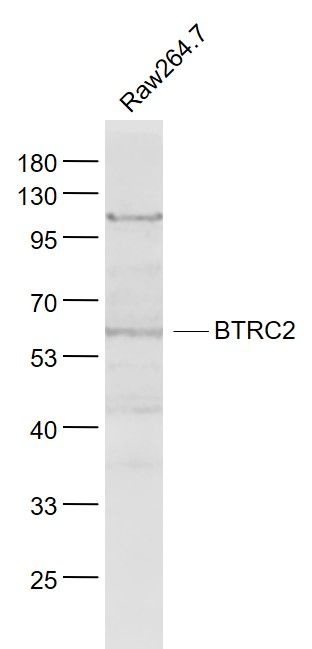Beta TRCP2 is a member of the F-box protein family which is characterized by an approximately 40 amino acid motif, the F-box. The F-box proteins constitute one of the four subunits of ubiquitin protein ligase complex called SCFs (SKP1-cullin-F-box), which function in phosphorylation-dependent ubiquitination. The F-box proteins are divided into 3 classes: Fbws containing WD-40 domains, Fbls containing leucine-rich repeats, and Fbxs containing either different protein-protein interaction modules or no recognizable motifs. The protein encoded by this gene belongs to the Fbws class and, in addition to an F-box, contains multiple WD40 repeats. This gene contains at least 14 exons, and its alternative splicing generates 3 transcript variants diverging at the presence/absence of two alternate exons.
Function:
Substrate recognition component of a SCF (SKP1-CUL1-F-box protein) E3 ubiquitin-protein ligase complex which mediates the ubiquitination and subsequent proteasomal degradation of target proteins. Recognizes and binds to phosphorylated target proteins. SCF(BTRC) mediates the ubiquitination of CTNNB1 and participates in Wnt signaling. SCF(BTRC) mediates the ubiquitination of NFKBIA, NFKBIB and NFKBIE; the degradation frees the associated NFKB1 to translocate into the nucleus and to activate transcription. Ubiquitination of NFKBIA occurs at 'Lys-21' and 'Lys-22'. SCF(BTRC) mediates the ubiquitination of phosphorylated NFKB1/nuclear factor NF-kappa-B p105 subunit, ATF4, SMAD3, SMAD4, CDC25A, DLG1, FBXO5 and probably NFKB2. SCF(BTRC) mediates the ubiquitination of phosphorylated SNAI1. May be involved in ubiquitination and subsequent proteasomal degradation through a DBB1-CUL4 E3 ubiquitin-protein ligase. Required for activation of NFKB-mediated transcription by IL1B, MAP3K14, MAP3K1, IKBKB and TNF. Required for proteolytic processing of GLI3.
Subunit:
Self-associates. Component of the SCF(FBXW11) complex formed of CUL1, SKP1, RBX1 and a FBXW11 dimer. Interacts with BTRC, BST2, PER1, RCAN1 and USP47. Interacts with phosphorylated ubiquitination substrate PER2 (By similarity). Interacts with phosphorylated ubiquitination substrates CTNNB1, NFKBIA, IFNAR1; the interaction requires the phosphorylation of the two serine residues in the substrates' destruction motif D-S-G-X(2,3,4)-S. Interacts with TRIM21.
Subcellular Location:
Cytoplasm. Nucleus.
Similarity:
Contains 1 F-box domain.
Contains 7 WD repeats.
SWISS:
Q9UKB1
Gene ID:
23291
Database links:
Entrez Gene: 23291 Human
Entrez Gene: 103583 Mouse
Omim: 605651 Human
SwissProt: Q9UKB1 Human
SwissProt: Q5SRY7 Mouse
Unigene: 484138 Human
Unigene: 28017 Mouse
| Picture |
Sample:
Raw264.7(Mouse) Cell Lysate at 30 ug
Primary: Anti- BTRC2 (SL8387R) at 1/1000 dilution
Secondary: IRDye800CW Goat Anti-Rabbit IgG at 1/20000 dilution
Predicted band size: 62 kD
Observed band size: 62 kD
|
|
|
